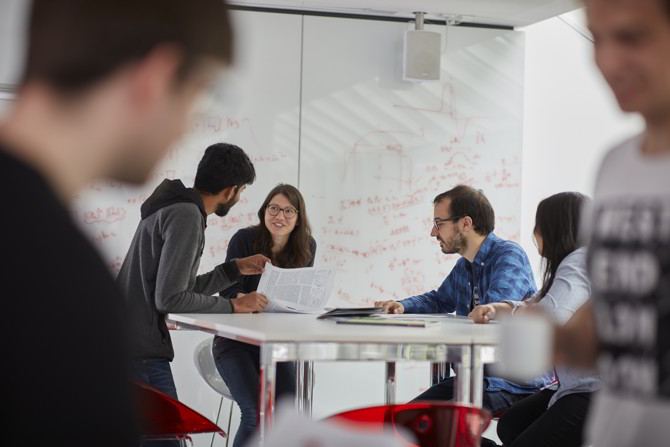Forschungsphase und Masterarbeit im M.Sc. Quantum Science & Technology

Forschungsphase
Inhalt der Forschungsphase
Zum Umfang der Forschungsphase beträgt 60 Credit Points (CP), entsprechend einem vollen Jahr (12 Monate). Inhalt des ersten halben Jahres sind erstens das Erarbeiten der notwendigen Spezialkenntnisse an der vordersten Front der aktuellen Wissenschaft (Masterseminar) und zweitens der Erwerb der Fertigkeiten der experimentellen bzw. theoretisch-mathematischen Praxis (Masterpraktikum), die Voraussetzung für die Durchführung des Forschungsprojektes im Rahmen der Masterarbeit sind. Jeder dieser beiden Bereiche bildet formal ein Modul, der Umfang beider Module zusammen beträgt 30 CP. Masterseminar und Masterpraktikum sind als Einführungsabschnitt der Forschungsphase zu verstehen. In der zweiten Hälfte der Forschungsphase führen Sie das Forschungsprojekt im Rahmen der Masterarbeit durch, das entsprechende Modul umfasst 30 CP. Abgeschlossen wird die Forschungsphase durch das Masterkolloquium im Rahmen dieses Moduls, in dem Sie Ihre Masterarbeit verteidigen. Die Module der Forschungsphase gehören inhaltlich zusammen, es ist nicht möglich separat nur eines der Module zu belegen.
In der Master-Arbeit wird selbständige wissenschaftliche Tätigkeit verbunden mit dem Erwerb von zusätzlichen Schlüsselqualifikationen wie zum Beispiel dem Projektmanagement, der Teamarbeit sowie der Darstellung und Präsentation wissenschaftlicher Ergebnisse.
| Modul | Anmerkung | CP | PL/SL* |
|---|---|---|---|
| Masterseminar | Fachliche Spezialisierung | 15 | S |
| Masterpraktikum | Methodenkenntnis und Projektplanung | 15 | S |
| Masterarbeit | 30 | P | |
| Summe | 60 | ||
Themenfindung
Der Prüfungsausschuss hat für diesen Studiengang eine Liste mit möglichen Themensteller(inne)n erstellt. Sie sind im Folgenden aufgeführt. Um ein Thema zu finden, nehmen Sie bitte selbständig Kontakt zu den möglichen Themensteller(inne)n auf.
Die Themensteller(innen) haben die Möglichkeit Themen auszuschreiben (beachten Sie dazu den Link "Zugang für Themensteller(innen)" rechts). Allerdings sind nicht alle möglichen Themen hier ausgeschrieben, eine Nachfrage bei den Themensteller(inne)n ist daher ratsam.
Weiterhin ist es sinnvoll, frühzeitig, etwa ein Semester im Voraus, mit der Suche nach einem geeigneten Thema zu beginnen. Bei einem persönlichen Gespräch können Sie schnell erkennen, ob Ihnen ein Thema zusagt, und ob Sie sich in einer Arbeitsgruppe wohlfühlen. Eine unpersönliche Mail mit einer Anfrage führt meist nicht zum gewünschten Ziel.
Suche und Einschränkung des Angebots
Angebot für Masterarbeiten
Keine Angebote für Masterarbeiten in der Datenbank.
Anmeldung der Forschungsphase
Die Anmeldung zu allen Modulen der Forschungsphase erfolgt beim Dekanat Physik der TUM in der Regel zu Beginn des dritten Semesters in einem Schritt. Dabei ist der Nachweis über das Mentorengespräch beizufügen. Nach Vereinbarung eines Themas mit der/dem zukünftigen Themensteller(in) können Studierende das Anmeldeformular ausdrucken.
Nach einem halben Jahr soll dann die Masterarbeit beginnen. Es werden Ihnen das Masterseminar und das Masterpraktikum gutgeschrieben und die formale Zulassung zur Masterarbeit wird erteilt.
Abgabe der Masterarbeit und Bewertung
Bevor Sie Ihre Masterarbeit einreichen, müssen Sie den Titel und dessen Übersetzung in der Datenbank (Zugang für Studierende) an den endgültigen Titel anpassen. und eine elektronische Kopie (PDF) hochzuladen. Ist das geschehen, geben Sie zwei gedruckte Exemplare im Dekanat Physik der TUM ab. Alternativ zur persönlichen Abgabe im Dekanat können Sie die zwei Druckexemplare auch per Post schicken – benutzen Sie dazu das Abgabe-Anschreiben, welches Sie nach dem Hochladen der PDF-Datei auf der Status-Seite herunterladen können, dieses enthält (wie das Abgabeformular) insbesondere die notwendige Erklärung nach §18 Absatz 9 APSO.
Die Arbeit gilt erst dann als abgegeben, wenn die zwei gedruckten Exemplare und das unterschriebene Abgabeformular bzw. (bei postalischer Einreichung das unterschriebene Abgabe-Anschreiben) physisch im Dekanat Physik eingegangen sind. Das Hochladen der elektronischen Kopie reicht nicht aus. Wenn die gedruckten Exemplare und das Abgabe-Anschreiben unverzüglich nach dem Hochladen abgeschickt wurden, interpretieren wir aber rückwirkend das Datum des Hochladens der elektronischen Kopie als Abgabedatum.
Eine Verlängerung der Frist ist nur in begründeten Fällen möglich. Siehe FAQ-Artikel zur Verlängerung von Abschlussarbeiten.
Die Masterthesis wird von der/m Themensteller(in) und einer/m Zweitgutachter(in) begutachtet und benotet. Die/Der Zweitgutachter(in) wird auf Vorschlag der/s Erstgutacherin/s (frühestens nach offizieller Anmeldung der Masterarbeit) durch den Prüfungsausschuss benannt.
Themensteller(in) und Zweitgutachter(in) benoten auch das abschließende Kolloquium.
Zum Ablegen von Prüfungsleistungen müssen Sie immatrikuliert sein. Sie müssen sich also nochmals rechtzeitig für das Abschlussemester rückmelden, wenn z. B. die Abgabe Ihrer Masterarbeit und das Masterkolloquium nicht mehr im laufenden Semester stattfinden wird.
Bei einem Abgabeziel der Masterarbeit oder einem geplanten Kolloquiumstermin etwa im Oktober sollten Sie daher die Rückmeldung (Frist jeweils 15.8.) zum Wintersemester nicht versäumen.
Organisation des Kolloquiums
Die Organisation und Durchführung des Masterkolloquiums obliegt der/m Themensteller(in) gemeinsam mit der/m Zweitgutachter(in). Für das Masterkolloquium sind ca. 60 Minuten, bestehend aus 30 Minuten Vortrag und 30 Minuten Disputation/Prüfung vorgesehen. Die Durchführung eines Kolloquiums kann auch im Rahmen eines Arbeitsgruppenseminars o. Ä. erfolgen.
Studienabschluss
Zum Ende des Semesters, in dem Sie die 120 Credit Points (CP) im Masterstudium erreichen und alle Prüfungs- und Studienleistungen erfüllt haben, werden Sie gemäß §13(1) ImmatSatzung exmatrikuliert. Im den meisten Fällen wird das Masterkolloquium die letzte Studien- bzw. Prüfungsleistung sein.
Erbringen weiterer Leistungen und Zeugnisdokumente
Da Sie nach dem Erfüllen der 120 CP des Masterstudiums grundsätzlich noch Studien- und Prüfungsleistungen erbringen können, die etwa im Katalogen der Fokussierung bereits vorhandene Leistungen ersetzen, ist es in der Regel erst nach Exmatrikulation möglich, die Abschlussdokumente zu erstellen. Beachten Sie dazu die Hinweise zum Studienabschluss und zu den Abschlussdokumenten.